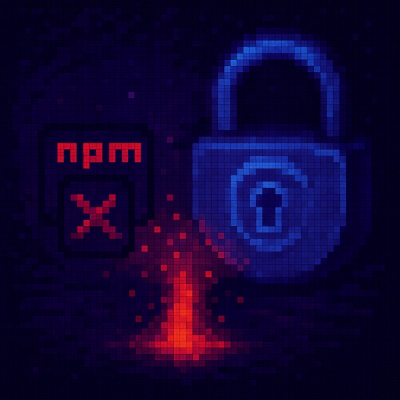
Security News
Software Engineering Daily Podcast: Feross on AI, Open Source, and Supply Chain Risk
Socket CEO Feross Aboukhadijeh joins Software Engineering Daily to discuss modern software supply chain attacks and rising AI-driven security risks.
Enables real-time collaborative editing of arbitrary JSON objects
diffsync is available via NPM for server and client (browserify & webpack):
npm install diffsync
If you are neither using browserify nor webpack for your client side code, you can get the latest version here:
https://wzrd.in/standalone/diffsync
For specific versions of the standalone version, simply add them to the URL like this (e.g. for version 2.1.0):
https://wzrd.in/standalone/diffsync@2.1.0
DiffSync-Todos: An example implementation of a collaborative todo list hosted on heroku. (Source code: https://github.com/janmonschke/diffsync-todos) Try it out with a couple of browser windows open for the same list :)
sync methodFor any questions about diffsync and general chat about collaborative websites, join our Slack channel :)
diffsync consists of a client and a server component which both implement their side of the Differential Synchronization Algorithm. These two components communicate via a custom protocol that was built on top of socket.io. However, socket.io is no hard dependency and it can be replaced by whatever communication library you wish, as long as it implements the socket.io interface.
The following paragraphs will show you how to get started. If you want to jump right into the code of a full example, head to diffsync-todos.
// if installed from standalone script or browserify / webpack
var DiffSyncClient = diffsync.Client || require('diffsync').Client
// socket.io standalone or browserify / webpack
var socket = window.io || require('socket.io-client')
// pass the connection and the id of the data you want to synchronize
var client = new DiffSyncClient(socket(), id);
var data;
client.on('connected', function(){
// the initial data has been loaded,
// you can initialize your application
data = client.getData();
});
client.on('synced', function(){
// an update from the server has been applied
// you can perform the updates in your application now
});
client.initialize();
/* --- somewhere in your code --- */
data.randomChange = Math.random();
// schedule a sync cycle - this will sync your changes to the server
client.sync();
The client is initialized by passing an instance of a socket.io connection (or a socket.io-compatible client) and the id of the object that should be synchronized with the server and other clients. The initialize method starts the synchronization.
The client object notifies the application about the sync-state via a couple of events:
connected: The client is connected to the server and the initial data has been loaded.synced: A new version from the server has been applied to the local data, you can update views nowerror: There was an error during synchronization.The data object that is being synced, can be accessed via the clients getData method. It can't be accessed before the connected event has been fired.
It is important that your application is altering the exact same object that is returned by getData because the algorithm synchronizes based on changesets of this object. Every update from the server is also applied to this very object and is notified by the synced event.
When your application has changed the state of this object, the sync method of the client needs to be called to trigger a sync with the server and other connected clients. Since the algorithm is based on sending diffs around, it is perfectly okay to call the sync method after every update on the data.
The diffsync-todos app provides an example client-side integration of diffsync into a todo list application. Check it out to find out how to integrate it into your existing application. In a nutshell, it makes use of Object.observe (and a polyfill for it) to track changes from within the app that are then synced to the server.
As a third optional parameter you can pass an options object to the constructor, that will then be applied to the internal diff-library. For a list of options, please check https://github.com/benjamine/jsondiffpatch#options.
Setting up the server in a very minimal way (with express):
// setting up express and socket.io
var app = require('express')();
var http = require('http').Server(app);
var io = require('socket.io')(http);
// setting up diffsync's DataAdapter
var diffsync = require('diffsync');
var dataAdapter = new diffSync.InMemoryDataAdapter();
// setting up the diffsync server
var diffSyncServer = new DiffSync.Server(dataAdapter, io);
// starting the http server
http.listen(4000, function(){
console.log('ready to go');
});
This is all that is needed for running the server part. There is no further addition necessary. Most of the logic is happening in the DataAdapter, which is described in the next section.
As a third optional parameter you can pass an options object to the constructor, that will then be applied to the internal diff-library. For a list of options, please check https://github.com/benjamine/jsondiffpatch#options.
A DataAdapter is used by the server component internally to fetch data to initialize the synchronization and to save the data periodically. The simple interface allows to write a custom data provider for which ever data source you are using in your web app.
The interface consists of two methods:
getData(id, callback):
id (String / Number) is the id of the datacallback (Function[err, data]) the callback that should be called after fetching the data. Normal node.js style with the first parameter being the error and the second parameter being the datastoreData(id, data, callback):
id (String / Number) is the id of the datadata (Object) the new version of the data that will be savedcallback (Function[err]) call back with an error if saving failedid or an _id field which can will be used by the diff-algorithm to identify moved objects in an arrayThe Differential Synchronization algorithm was invented by Neil Fraser in 2009. He wrote a paper about that can be found here: https://neil.fraser.name/writing/sync/. In addition to that, he held a Google Tech Talk about it, which is available on YouTube: https://www.youtube.com/watch?v=S2Hp_1jqpY8.
Neither client, nor server ship with a dependency of socket.io. This allows to replace the transportation layer with a completely different library which is compatible to the socket.io interface. This implementation relies on named-events, acknowledgments, rooms and it does not make any assumption about the underlying transportation protocol.
FAQs
Real time collaborative editing for JSON objects
We found that json-sync demonstrated a not healthy version release cadence and project activity because the last version was released a year ago. It has 1 open source maintainer collaborating on the project.
Did you know?

Socket for GitHub automatically highlights issues in each pull request and monitors the health of all your open source dependencies. Discover the contents of your packages and block harmful activity before you install or update your dependencies.

Security News
Socket CEO Feross Aboukhadijeh joins Software Engineering Daily to discuss modern software supply chain attacks and rising AI-driven security risks.

Security News
GitHub has revoked npm classic tokens for publishing; maintainers must migrate, but OpenJS warns OIDC trusted publishing still has risky gaps for critical projects.

Security News
Rust’s crates.io team is advancing an RFC to add a Security tab that surfaces RustSec vulnerability and unsoundness advisories directly on crate pages.